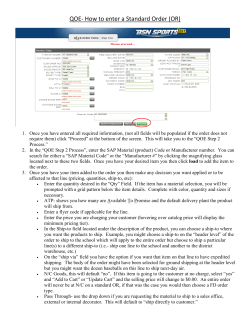
Radiation of Ship Windows Induced by Structure-borne Sound Why
Radiation of Ship Windows Induced by Structure-borne Sound S. Semrau, Ch. Weißenborn Germanischer Lloyd, Hamburg, Germany, Email: christof.weissenborn@gl-group.com Why Nowadays there is a trend in exterior passenger ship design for the use of larger and larger glass surfaces. When we talk about acoustics here, we are not referring to the occasional noise coming from outside the vessel. Rather, the issue is structure-borne noise (SBN), which is present at all times onboard ship and can stimulate large ship windows to radiate annoying sound into typical passenger areas. to 15% of the boundary surface areas are windows, their contribution may dominate the overall SPL. We present and discuss the measurements of the sound radiation carried out to validate our FEM-based calculation approach [1], whose successful verification allows the use of the method in the overall acoustical consulting process for the ship. ShipAcoustics The major sources of SBN onboard are the main and auxiliary engines and the propeller, but they may also include the air-conditioning units and the thrusters. All of these sources may transmit their vibration energy through the hull, stiffeners, piping etc. as structureborne noise, and then over the adjacent strucutures on into cabins and other interior spaces as airborne noise (ABN). In our sound level predicition process, we calculate the SBN propagation throughout the whole ship using GL.NoiseFEM, our SEA-based energy finite element formulation [2]. With the results from this calculation, the final sound pressure level (SPL) in a room is then obtained with a semi-empirical approach. Figure 2: Contribution of boundary surfaces to the total sound pressure level in a representative room onboard ship Windows onboard Ships The acoustical properties of a window are normally characterised by its transmission loss Rw , describing the airborne-to-airborne noise insulation. Applied on a ship windows, you find the situation in Figure 3, where the ABN acts as a distributed two-dimensional load on the outer pane of a multilayered window. The resulting vibration energy is partly dissipated via the frame. Figure 1: Structure-borne noise intensity of a Blohm+Voss fast cruise liner, calculated with GL.NoiseFEM For interior components (floor, wall, linings) there are normally secondary acoustical measures used (mineral wool, damping layers, local stiffeners) that are not applicable on windows. Furthermore, the area of bare glass surfaces is increasing, which makes dedicated attention to its acoustical behaviour a necessity. In Figure 2 you see a typical breakdown of the boundary surfaces to the SPL in a large representative room. Although only 5% Figure 3: Airborne - to - airborne noise transmission In contrast to this civil engineering approach, the omnipresent SBN onboard exposes the window to a concentrated and linear vibrational load via the edges, which stimulates the whole glass package, including the inner pane. Moreover, there is a continuous energy inflow via the frame. Figure 4: Structure-borne - to - airborne noise transmission To describe how effective a surface can convert mechanical vibration energy into airborne noise, the radiation efficiency σ is used, defined as σ= P ρcS v¯2 (1) Figure 5: Modified room-mockup for radiation measurement As the supplier often delivers complete window systems, four different frame and window fixation designs were investigated. The test objects (approx. 2000 mm by 1600 mm) were specified in cooperation with Fehrmann Hamburg [5], making use of all their specific know-how they have built up over decades in high-end ship windows. Measurements where P is the radiated sound power, ρc the characteristic impedance of air, v¯2 the mean quadratic velocity of the vibrating surface and S the surface area. For the same structure, σ can be very different depending on the above described linear or planar excitation mechanism [3]. Radiation As windows are finite plane surfaces, they radiate noise even below the coincidence frequencies of the bending wave. Due to the well known effects of corner and edge radiation, a window’s pane is an effective noise source in the frequency range of the first four or five eigenmodes (up to 100 Hz). Consequently, the final radiation behaviour is also highly dependent on the vibrational mode shape which leads to the question of the plate’s boundary constraints: The window’s frame and fixation design determines how evenly the modes are and how effective its individual contribution to the radiation turns out. Surface Velocity To realize a representative SBN distribution in the steel structure, a shaker was placed under the rear part of the mockup, driven by broadband uncorrelated signals between 31 Hz and 1000 Hz. The window is mounted with the radiating pane pointing outside to get a semi-infinite radiation situation. In order to give the most accurate reading of the surface vibration velocity, we made use of a contactless Scanning Laser Vibrometer (SLV). With a control accelerometer placed on the radiating window we took a reference signal, which delivered the necessary phase relation for a modal analysis. In Figure 6 you can also see the surface partitioning for both the 120 laser beam positions (dotgrid) and the nine subsurfaces for the sound power measurements. Full-scale Test Rig Due to our long-term cooperation with the German navy and a local shipyard, we have access to two full-scale mock-ups of typical ship structures: A deckhouse (approx. 13 m by 9 m by 7 m) and a single room (approx. 6 m by 3 m by 3 m). Both test structures were constructed using ship-like dimensions of stiffeners and plates. We modified the room mock-up (Figure 5) in a way that it can be used for measuring the structure-borne noise induced radiation of a ship’s window. Figure 6: SBN excitation and surface partitioning Sound Power In a next step we acquired the radiated airborne sound power by means of a sound intensity probe. The spatial distribution over the windows surface and the frequency can be found in Figure 7. Figure 9: Driving-point impedance of different panes Validation of Simulation Figure 7: Spatial distribution of the radiated sound power over frequency A vibro-acoustic model of the window and the adjacent steel structure was set up to calculate the radiation behaviour of the tested ship windows. Special attention has been paid to the a proper consideration of the nearfield effects, finally showing a good correlation between simulation and reality. The measurement were taken in the nearfield distance at the center of the nine subsurfaces shown in Figure 6. Both vibration and sound power measurements were carried out for all four windows, and for each one the radiation efficiency was calculated. In Figure 8 you can see a comparison for all test prototypes. It has to be stated that no clear precedence for one of the windows in term of their radiation behaviour can be found. Figure 10: FE-model of one specific window Figure 8: Measured radiation efficiency of four different windows Impedances Prior to the shaker excitation, the driving-point or input impedances of the windows have been measured by the impact method to get a sufficient indication of the relation between the ship structure and the radiating pane, see Figure 9. It is essential for the correct interpretation of the radiation efficiency (regardless whether calculated or measured) in the later prediction stages. Figure 11: Comparison of calculated and measured radiation efficiency σ Conclusion The suitability of a vibro-acoustic radiation calculation for large ships windows was proved. It must be stated that the distribution of the structure-borne noise in the ships structure and the specific peculiarities of ship window systems are the key issues this application. Variational calculations have shown that the entire system, consisting of - glass package (panes, insulation gaps, PVB layers), - the fixation of the glass package, - frame design - the interface between frame and the ship’s superstructure - dynamic properties of the surrounding structure have to be taken into account. In addition to the window designs investigated so far, a further five windows featuring different glass packages, different dimensions, different fixings (clamped vs. bonding) and different framing will be built and investigated. References [1] Vibro-Acoustic Simulation of Structure-borne Induced Radiation of Ship Windows. Proceedings of DAGA (2009), in press [2] Matthies, H., Cabos, C. A method for the prediction of structure-borne noise propagation in ships. Sixth International Congress on Sound and Vibration. Copenhagen (1999), p.2349-2356 [3] Heckl, M., Cremer, L. K¨ orperschall. Springer, Berlin, 1996 [4] Actran User’s Manual, Free Field Technologies, 2007 [5] Window supplier Fehrmann. URL: http://www. fehrmann-hamburg.de
© Copyright 2025















